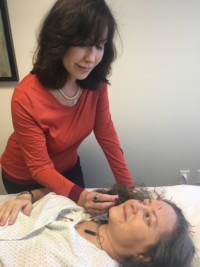
Lucy Postolov and one happy patient
Journal Review Aug. 19, 2019
Dear Doctor: What do you think about acupuncture for lower back pain? What is it, and how does it work?
Dear Reader: Acupuncture is a key component of traditional medicine in China, but until recently, it was viewed as alternative therapy here in the United States. Then, in 1997, the National Institutes of Health issued a pro-acupuncture consensus statement, acknowledging acupuncture as an effective tool for managing pain and nausea. The agency also recommended that acupuncture be taught in medical schools. As doctors, we both see a role for acupuncture in our practices. Dr. Ko recently finished her training in acupuncture and uses this treatment.
Acupuncture is a centuries-old practice that builds on the premise that the human body contains energy pathways, known as meridians, which are comprised of more than 2,000 specific points. During an acupuncture treatment, a practitioner stimulates certain groups of points by inserting hair-thin sterile needles. The feeling is more of a distinct sensation than actual pain. Acupuncture needles may also be heated during a treatment, or they can be stimulated to conduct a mild electric current. A usual course of treatment typically includes multiple sessions that can continue for weeks or months.
Despite centuries of use, modern medicine doesn’t really understand how this ancient technique works. One theory ties the stimulation of acupuncture points to the release of specific biochemicals, which play a role in healing, as well as physical and emotional well-being.
A study published in 2014 used advanced 3D imaging techniques to examine acupuncture points at the cellular level. The researchers found that, unlike neighboring tissues, acupuncture points contained a high density of micro-vessels and other vascular structures. Not a definitive answer to the mysteries of acupuncture, but certainly an intriguing start.
Clinical studies have shown the value of acupuncture for pain relief, nausea, headache and osteoarthritis. A growing number of medical insurance plans cover acupuncture treatments. The U.S. armed services now use acupuncture as a form of pain management. And the Centers for Medicare & Medicaid Services is considering a proposal to cover acupuncture treatments for patients with chronic lower back pain participating in certain clinical trials.
If you do decide to try acupuncture, please be sure to find an experienced practitioner. As with many integrative therapies, licensing requirements vary from state to state. If you live in an area that doesn’t have licensing requirements or oversight for acupuncturists, consider looking for a practitioner certified by the National Certification Commission for Acupuncture and Oriental Medicine, a national oversight and advocacy organization. You can find more information at nccaom.org. www.lucypostolovacupuncture.com
